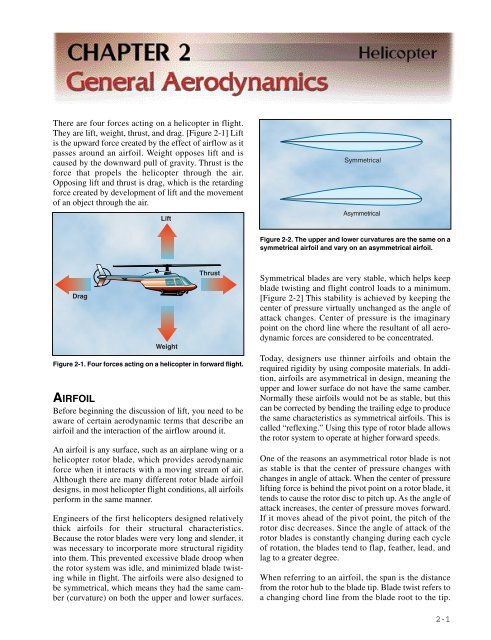Rotorcraft Flying Handbook, FAA-H-8083-21
Rotorcraft Flying Handbook, FAA-H-8083-21
Rotorcraft Flying Handbook, FAA-H-8083-21
You also want an ePaper? Increase the reach of your titles
YUMPU automatically turns print PDFs into web optimized ePapers that Google loves.
There are four forces acting on a helicopter in flight.<br />
They are lift, weight, thrust, and drag. [Figure 2-1] Lift<br />
is the upward force created by the effect of airflow as it<br />
passes around an airfoil. Weight opposes lift and is<br />
caused by the downward pull of gravity. Thrust is the<br />
force that propels the helicopter through the air.<br />
Opposing lift and thrust is drag, which is the retarding<br />
force created by development of lift and the movement<br />
of an object through the air.<br />
Lift<br />
Symmetrical<br />
Asymmetrical<br />
Figure 2-2. The upper and lower curvatures are the same on a<br />
symmetrical airfoil and vary on an asymmetrical airfoil.<br />
Drag<br />
Weight<br />
Thrust<br />
Figure 2-1. Four forces acting on a helicopter in forward flight.<br />
AIRFOIL<br />
Before beginning the discussion of lift, you need to be<br />
aware of certain aerodynamic terms that describe an<br />
airfoil and the interaction of the airflow around it.<br />
An airfoil is any surface, such as an airplane wing or a<br />
helicopter rotor blade, which provides aerodynamic<br />
force when it interacts with a moving stream of air.<br />
Although there are many different rotor blade airfoil<br />
designs, in most helicopter flight conditions, all airfoils<br />
perform in the same manner.<br />
Engineers of the first helicopters designed relatively<br />
thick airfoils for their structural characteristics.<br />
Because the rotor blades were very long and slender, it<br />
was necessary to incorporate more structural rigidity<br />
into them. This prevented excessive blade droop when<br />
the rotor system was idle, and minimized blade twisting<br />
while in flight. The airfoils were also designed to<br />
be symmetrical, which means they had the same camber<br />
(curvature) on both the upper and lower surfaces.<br />
Symmetrical blades are very stable, which helps keep<br />
blade twisting and flight control loads to a minimum.<br />
[Figure 2-2] This stability is achieved by keeping the<br />
center of pressure virtually unchanged as the angle of<br />
attack changes. Center of pressure is the imaginary<br />
point on the chord line where the resultant of all aerodynamic<br />
forces are considered to be concentrated.<br />
Today, designers use thinner airfoils and obtain the<br />
required rigidity by using composite materials. In addition,<br />
airfoils are asymmetrical in design, meaning the<br />
upper and lower surface do not have the same camber.<br />
Normally these airfoils would not be as stable, but this<br />
can be corrected by bending the trailing edge to produce<br />
the same characteristics as symmetrical airfoils. This is<br />
called “reflexing.” Using this type of rotor blade allows<br />
the rotor system to operate at higher forward speeds.<br />
One of the reasons an asymmetrical rotor blade is not<br />
as stable is that the center of pressure changes with<br />
changes in angle of attack. When the center of pressure<br />
lifting force is behind the pivot point on a rotor blade, it<br />
tends to cause the rotor disc to pitch up. As the angle of<br />
attack increases, the center of pressure moves forward.<br />
If it moves ahead of the pivot point, the pitch of the<br />
rotor disc decreases. Since the angle of attack of the<br />
rotor blades is constantly changing during each cycle<br />
of rotation, the blades tend to flap, feather, lead, and<br />
lag to a greater degree.<br />
When referring to an airfoil, the span is the distance<br />
from the rotor hub to the blade tip. Blade twist refers to<br />
a changing chord line from the blade root to the tip.<br />
2-1

















